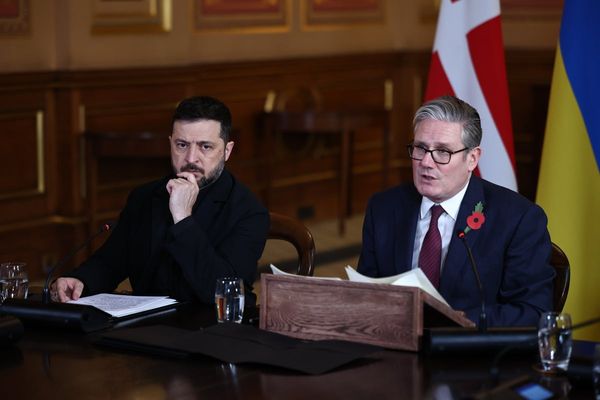The world’s media are currently busy recording the tales of released Israeli hostages, freed Palestinian prisoners and their families after a ceasefire came into effect for the war in Gaza. But they are doing so while still being held at a distance from the centre of the story.
Foreign journalists have been banned by Israel from entering the Gaza Strip independently since the start of the war. And senior members of the international media are not optimistic that access to Gaza will change any time soon.
I asked Phil Chetwynd, global news director at Agence France-Presse (AFP), why he thought Israel was so insistent at keeping out external reporters. He told me:
Any situation where independent media are kept out or targeted gives rise to questions about the motivation. We are told it is because of our safety, but we have been covering wars non-stop for the past 100 years. We are ready to assume the risks. Given the extraordinary high death toll of journalists in Gaza, we have to presume it is a deliberate attempt to stop media revealing the full impact of the war and the Israeli military campaign.
Read more: How Israel continues to censor journalists covering the war in Gaza
He reflected on how AFP would like to plan its coverage.
Our Palestinian journalists have done an amazing job, but all our Gaza staff journalists were evacuated over a year ago. They would like to return. The Palestinian freelancers who work for us have also done incredible work, but they are absolutely exhausted after two years of conflict. So we need journalists to be able to enter the Gaza Strip – I do not make a distinction between Palestinian and international.
He added:
I think it is important to have fresh eyes on the situation on the ground. I would also say it is sometimes easier for international journalists to report more freely on the activities of Hamas.
Reporting on Gaza
For the past two years, the only access Israel has provided for foreign media to enter Gaza has been under embedded conditions with the Israeli military. In the weeks following the October 7 Hamas attacks in 2023, a number of British reporters including from the BBC and Channel 4 News did avail of this restricted coverage. American correspondents and news agencies have also taken up offers.
But this access has been sporadic and has favoured Israeli journalists. In August 2025, an ABC Australia team managed to secure an “embed” trip to the Kerem Shalom aid site in southern Gaza after repeated requests were turned down.
In his report, ABC’s Matthew Doran pointed out that embeds are “highly choreographed and controlled”. However, Doran explained that he accepted the trip as “an opportunity to gain access to a site Israel is using to prosecute its case it is trying to feed the population of Gaza – an argument the humanitarian community, and world leaders, argue is full of holes”.
Doran noted that the small embed trip included an Israeli media outlet, an Israeli writer and “a handful of social media influencers”, all eager to post pro-Israeli sentiments. Israel has consistently accused the international media of succumbing to Hamas propaganda.
A number of initiatives have been tried over the past 24 months to enable external reporters access to Gaza. The Foreign Press Association (FPA) in Jerusalem has challenged the restrictions in Israel’s supreme court.
On September 11, the FPA noted that it had been a full year since it submitted its second petition to the court. But despite the urgency, it said “the court has repeatedly agreed to the [Israeli] government’s request for delays and postponed one hearing after another”.
Read more: Gaza: high numbers of journalists are being killed but it's hard to prove they're being targeted
Petitions have also been sent to the Israeli authorities with the backing of international media organisations and groups such as Reporters Without Borders and the Committee to Protect Journalists (CPJ). Both of these have coupled their campaigns with calls for an immediate end to the killing of Palestinian journalists in Gaza who have been the world’s only eyes on the conflict as witnessed by those under fire.
According to the CPJ’s Jodie Ginsberg, writing in the Guardian in August, more than 192 journalists and media workers have been killed in Gaza since the start of the war. This number includes 26 journalists whom the CPJ believes have been targeted deliberately in “the deadliest conflict for journalists that we have ever documented”.
Israel has denied targeting journalists, except in cases where it has accused particular Palestinian journalists of being terrorists. The CPJ has argued in return that Israel should stop “its longstanding practice of labelling journalists as terrorists or engaging in militant activity, without providing sufficient and reliable evidence to support these claims”.
As recently as September, the BBC along with AFP, Associated Press and Reuters launched a film calling on the Israeli authorities to allow the international press access to Gaza. It noted the media’s part in informing the world about the D-Day landings, the Vietnam war, the Ethiopian famine, the Tiananmen Square massacre, the Rwandan genocide, the Syrian refugee crisis and the current conflict in Ukraine.
David Dimbleby’s narration calls on Israel to allow international reporters in, “to share the burden with Palestinian reporters there so we can all bring the facts to the world”.
But looking at the current stalemate, a cynic might ponder if the the first open access to Gaza will be to the Washington press caravanserai that will surely be allowed in to document the rebuilding of Gaza into a Trump-envisioned riviera.
Colleen Murrell has received funding from Irish regulator Coimisiún na Meán (2021-4) for research for the annual Reuters Digital News Report Ireland.
This article was originally published on The Conversation. Read the original article.







